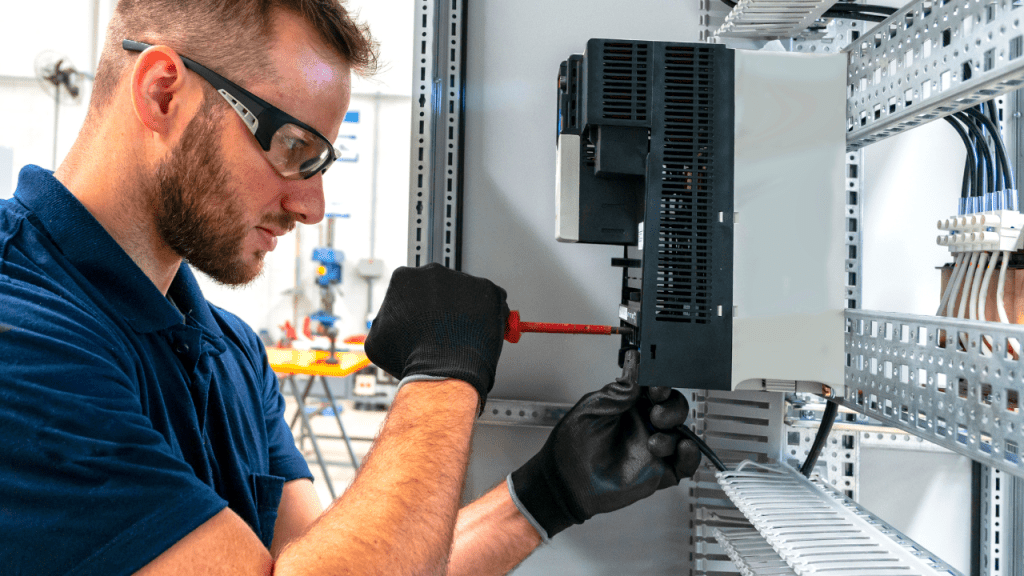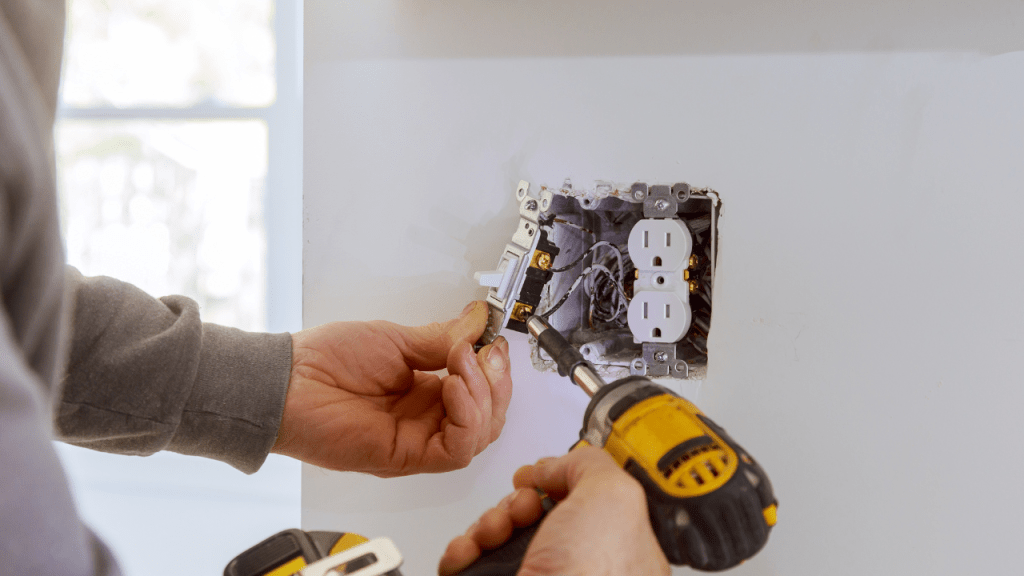As a plastic bottle floats along the ocean, contrastingly, a plastic consumer unit sits in your home, both raising environmental and safety concerns respectively.

From my years of experience as an electrical engineer, I’ve pondered whether the material of a consumer unit, plastic or otherwise, could result in it failing an Electrical Installation Condition Report (EICR). It’s not as black and white as you might think, and I’m here to guide you through this gray area.
So, do plastic consumer units really fail an EICR? Let’s take a closer look.
Understanding Regulations and Compliance
To fully understand the regulations and compliance requirements for plastic consumer units, it’s essential to familiarize oneself with the BS7671 Amendment 3, which applies to new electrical installations from July 2015 onwards. This amendment made significant changes to safety considerations, especially around plastic vs metal compatibility.
In terms of retrofitting options, there’s no immediate need to change from plastic to metal unless the existing consumer unit is inadequate. If a new circuit is added, however, it must be protected by a residual current device (RCD) for compliance. Interestingly, there are regulatory exemptions for older installations. These can pass inspections under Regulation 651.2, as long as they’re free from defects.
Installation standards now mandate metal enclosures for domestic properties. However, it’s crucial to note that plastic consumer units can still be used in commercial or detached structures. Remember, the material of the consumer unit is less important than proper installation and maintenance. An incorrectly installed metal enclosure may not guarantee safety. Ultimately, understanding and adhering to these regulations is paramount. They’re designed to ensure the safety and compatibility of all installations, regardless of enclosure material.
Enclosure Types: Plastic Vs Metal
Diving into the specifics of enclosure types, it’s crucial we differentiate between plastic and metal consumer units, each with their unique characteristics and compliance considerations.
In a material comparison, plastic units are lightweight and generally cheaper, while metal ones are robust, providing an extra layer of protection against fires. Safety considerations differ as well; plastic units can melt in a fire, increasing the risk, while metal enclosures are fire-resistant, offering enhanced protection.
Installation requirements are more stringent for metal units, demanding expert knowledge and precision. They’re often selected for new installations, aligning with the latest standards. Plastic units, while easier to install, may not meet current regulations for residential properties.
The maintenance implications of both are significant, with plastic units requiring frequent checks for wear and tear. Metal units, on the other hand, are durable, needing less frequent maintenance.
Lastly, when considering upgrading options, it’s important to note that while metal units are now the standard, retrofitting isn’t always necessary. If your plastic consumer unit is still in good condition and meets safety standards, an upgrade mightn’t be required. Always consult with a qualified electrician to make the best choice.
Navigating EICR Classification Criteria
Understanding the EICR classification criteria is crucial for both electricians and consumers, as it directly impacts how we assess the safety and compliance of consumer units. Misconceptions abound regarding plastic CUs, with many presuming their automatic failure in an EICR. This isn’t necessarily true.
The EICR classification revolves around three codes: C1, C2, and C3. C1 indicates danger present, C2 points to potential danger, and C3 suggests improvement needed. The material of the CU isn’t the sole determinant of these codes; inspection criteria also involve looking at the overall condition and safety of the installation.
Here are the key details:
| EICR Classification | Meaning | Implication for Plastic CUs |
|---|---|---|
| C1 | Danger present | Unlikely due to CU material |
| C2 | Potential danger | Possible if CU is badly damaged |
| C3 | Improvement needed | Possible if CU is old, but doesn’t imply failure |
Verifying Installer Accreditation

Before you hire an installer for your consumer unit upgrade, it’s crucial to verify their accreditation to ensure they’re competent and authorized to carry out the job. Accreditation verification is a vital step in securing installation safety, as it authenticates the installer’s qualifications and adherence to regulatory compliance.
So, how can you assess the competency of an installer? First, check if they’ve obtained a recognized qualification in electrical installation. This denotes that they’ve undergone rigorous training and have the technical knowledge to handle electrical tasks proficiently.
Next, look for their membership in accredited bodies like the National Inspection Council for Electrical Installation Contracting (NICEIC) or the Electrical Contractors’ Association (ECA). Membership in such organizations demonstrates their commitment to upholding industry standards.
Also, ensure that the installer is registered with a Competent Person Scheme (CPS), which validates their ability to self-certify their work under Building Regulations in the UK. You can cross-check their registration online using the Electrical Competent Person’s website.
Addressing Common Misconceptions About EICRs
Let’s clear the air about some common misconceptions surrounding Electrical Installation Condition Reports (EICRs). Many misunderstandings revolve around safety assessments, material misconceptions, inspection misconceptions, installer qualifications, and electrical standards.
For starters, not all plastic consumer units (CUs) will fail an EICR. The material of the CU isn’t as critical as its condition and installation quality. Therefore, a well-maintained plastic CU can pass an EICR.
Secondly, an EICR doesn’t require an installation to conform to the latest electrical standards. Instead, it should meet the standards in effect at the time of its installation, unless there’s a safety concern.
Finally, not just anyone can perform an EICR. The inspector must have proper qualifications and experience to evaluate the safety of electrical installations accurately.
To illustrate these points, consider the following table:
| Misconception | Truth |
|---|---|
| All Plastic CUs fail EICRs | Condition and installation quality matter more |
| EICRs require latest standards | Standards at time of installation suffice unless safety is at risk |
| Any electrician can perform EICR | Only qualified and experienced inspectors should conduct EICRs |
Frequently Asked Questions
What Are the Potential Risks Associated With Using a Plastic Consumer Unit?
I’m aware that plastic consumer units pose potential risks like fire hazards, material degradation, and environmental impacts. They also may have insurance implications and health concerns due to potential toxic fumes if they catch fire.
How Can I Identify if My Consumer Unit Needs to Be Upgraded?
I’d look at the unit’s lifespan, maintenance frequency, and cost comparison. If it’s aging or frequently repaired, upgrading may be wise. I’d also consider professional recommendations and the upgrading process costs.
What Are the Potential Benefits of Upgrading to a Metal Consumer Unit, Even if My Current Plastic One Doesn’t Fail an Eicr?
Upgrading to a metal consumer unit, even if my plastic one’s sound, has benefits. Metal’s longevity, cost effectiveness, fire resistance, enhanced safety, and modern aesthetics make it a wise, future-proof investment in my property’s electrical system.
If My Installer Is Not Accredited, What Steps Should I Take to Ensure the Safety of My Electrical Installation?
If my installer isn’t accredited, I’d verify their qualifications, understanding the risks involved. Safety measures are critical, hence the importance of accreditation. I’d secure professional help to ensure the safety of my electrical installation.
Can a Consumer Unit Pass an EICR but Still Be Unsafe for Use?
Yes, a consumer unit can pass an EICR but still be unsafe due to incorrect EICR interpretation, lack of safety measures, or EICR limitations. Accreditation and exploring consumer unit alternatives are essential for ensuring safety.
Conclusion
So, in essence, a plastic consumer unit doesn’t inherently fail an EICR. The key is to understand regulatory nuances, the impact of unit material, and the importance of installer accreditation.
Don’t be swayed by misconceptions. Compliance is much more than just metal or plastic. It’s about safety, good practice, and adhering to established standards.
As with most things in our field, knowledge is power. Keep learning, stay informed, and let’s strive for safer installations.
Contact us now to schedule an appointment for a fire risk assessment.









